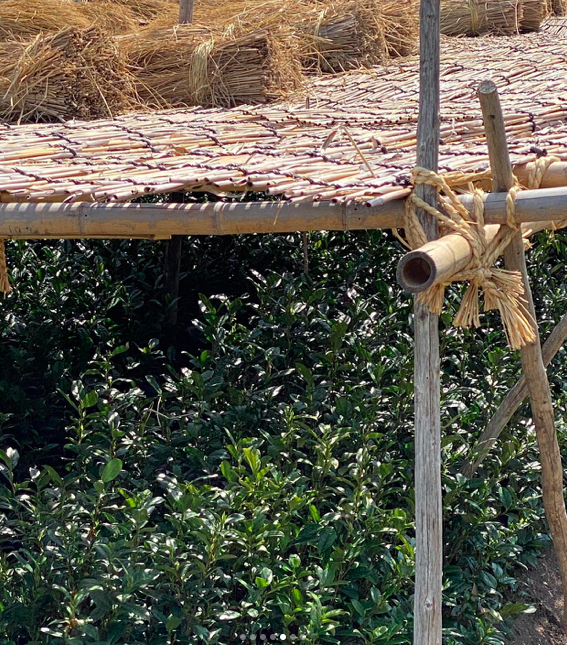As you know, many tea merchants sell their own brand of matcha tea at a very reasonable price. There are a few main reasons why the price of matcha varies so much:
1. Top Grade Matcha is Grown Under Shade
Many Japanese tea farmers use special black shades to protect their tea leaves, as strong direct sunshine produces tannins, which cause a bitter taste. Red wine contains quite a lot of tannin, which causes the bitterness and astringency found in red wine. By growing under shade, the amount of tannin and bitterness is reduced a lot, resulting in a sweeter and more gentle matcha. Growing under shade also means the tea leaves grown much more slowly, so these tea leaves can only be harvested once a year.
Traditionally Japanese tea makers used thatched straw to protect the tea leaves. The farmers would shake them and seeds and dried leaves which had collected on top would fall down into the soil around the tea trees becoming natural fertiliser. It’s a very labour-intensive process, so many tea farmers use these black shades, which were developed specially for Japanese tea farming. These black shades are 7 times more efficient than the thatched one. Our tea makers, Ippodo and Marukyu Koyamaen, use both methods to produce their matcha, depending on the grade.
2. Stone Ground or Machine Ground
After they’re harvested, tea leaves are steamed, dried, and then ground. Traditionally very hard stone mills are used to produce a very fine powder. This is the traditional method, and the one used by our tea makers. The top makers use this method even though it is much slower, as stone grinding produces a lot less heat (no more than 40°C) and so preserves the flavour and colour of the matcha. To keep the heat down, the dried tencha (shaded green tea leaves) are ground slowly, and one stone produces only 40g of matcha per hour.
Many of the more reasonably priced matcha and culinary matcha teas are ground using a machine with a ceramic ball. They put the tencha and even unshaded green tea leaves into the machine, and the ceramic ball breaks the dried leaves apart to produce powder. Using this method, a lot of green tea powder can be made quickly. The machine’s temperature can reach up to 90°C, so a water-cooling system is used to reduce the heat.
3. Hand Picking or Machine Picking
The very top grades of matcha tea are only harvested once a year. The first week of May is the traditional harvest time. However, lower grades of tea are harvested a few times a year as they are grown without shade. These matcha teas that are harvested multiple times a year are cheaper yes, but often quite bitter as they are grown in full sun. Some countries only pick tea by hand if their cost of labour is relatively low. In Japan the cost of labour is high, so tea is picked both by hand and by machine. Machine picking can damage some tea leaves when they are harvested, as well as picking older leaves. However, they are very efficient in terms of time. For some top grades of matcha only the tip of the leaf is picked as it is the youngest and most tender part and is almost sweet.
If you have any questions regarding matcha tea, then please feel free to contact me. I'm more than happy to answer any questions. If I don’t know the answer, I’ll ask my tea ceremony teachers or our tea makers! I learn new things every day and I would love to create a peaceful tea community to exchange ideas and information, which will be productive and informative for all of us.

